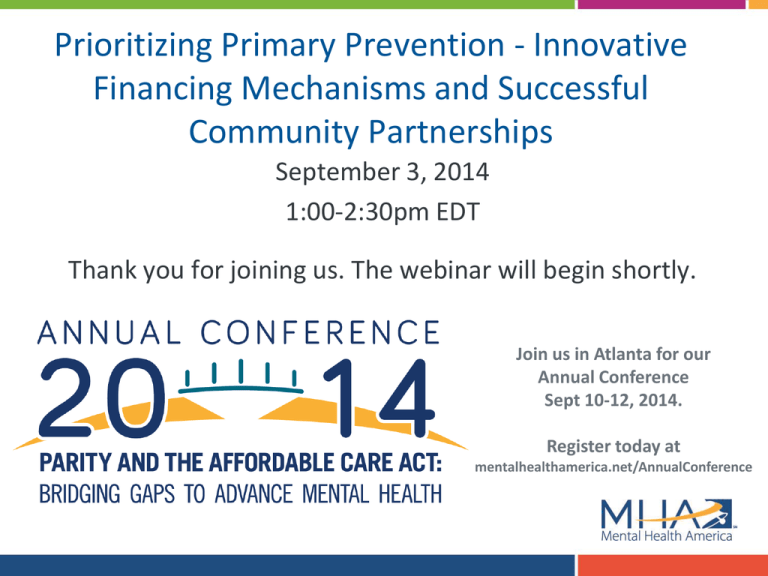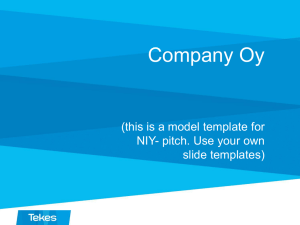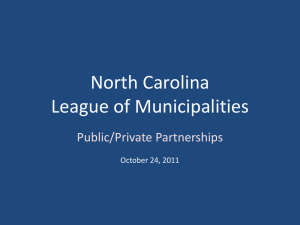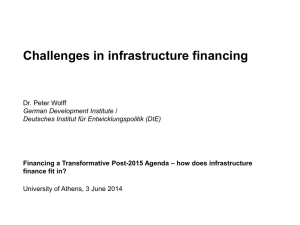Prioritizing Primary Prevention
advertisement

Prioritizing Primary Prevention - Innovative Financing Mechanisms and Successful Community Partnerships September 3, 2014 1:00-2:30pm EDT Thank you for joining us. The webinar will begin shortly. Join us in Atlanta for our Annual Conference Sept 10-12, 2014. Register today at mentalhealthamerica.net/AnnualConference Prioritizing Primary Prevention - Innovative Financing Mechanisms and Successful Community Partnerships September 3, 2014 Financing and Implementation of Primary Prevention: An Overview Sarah M. Steverman, Ph.D., M.S.W & David L. Shern, Ph.D. Presentation Overview Challenges and opportunities Federal financing ACA related prevention financing Insurance financing for prevention Private financing of prevention Implementation strategies Example – 5 Town CTC Example – MHA of OK Challenges U.S. trails other developed nations on many indicators of health and wellbeing Highest rates of mental illness in the world Lowest performing health care system of 16 comparable nations Highest rates of incarceration in the world Lagging academic achievement These are significant threats to our competitiveness/quality of life Opportunities Behavioral health is a key factor for addressing these challenges We have well studied interventions that can impact most of these areas Financing for these interventions is spread across Levels of government Sectors of interest Private, public and philanthropic sources Schematic Representation of Prevention Financing Challenge for Stakeholders How best to understand and coordinate these diverse sources of funding Develop funding in areas that are not well supported Understand the overall yield of our investment Ensure sustainability of prevention funding Community based organizations can be the drivers of these activities Opportunities General health and behavioral health can be promoted, and health and social problems can be prevented. General health, behavioral health, and social outcomes share a common set of predictors that are of concern to many different human service sectors Sectors have shared overall goals of healthy development, but different financing, interventions, and indicators Federal, state, and local stakeholders are invested in individual, family, and community wellbeing Opportunities A substantial science base exists that demonstrates the value of primary prevention interventions on •Pro-social behaviors •Reduction of risk factors •Educational and occupational achievement •Psychosocial and interpersonal functioning •Prevention of mental health and substance abuse conditions Over the lifetime Opportunities This value is reflected in improved human capital with savings in both direct and indirect public expenditures in Education Health Criminal Justice Child Welfare Social Welfare Programs As well as improved human capital contributing to increased productivity and broadly distributed societal good. Business and employer benefits Increased community and civic engagement Improved family and individual health and well-being Intervention Costs and Benefits Total Benefit Taxpayer Benefit Cost Net Value Benefit to Cost Ratio Seattle Social Development $15,238 $4,591 $3,081 $12,157 $4.94 Good Behavior Game $8,890 $2,655 $158 $8,732 $56.34 Strengthening Families (1014) $4,259 $1,061 $1,098 $3,160 $3.89 Communities that Care $2,079 $626 $574 $1,505 $3.70 Intervention WSIPP. (2014). Benefit-Cost Results - General Prevention. http://www.wsipp.wa.gov/BenefitCost?topicId=6 Overarching Goals Every individual should have the opportunity to live, learn, work and play in safe, nurturing and caring environments that support healthy development. Every individual should have access to evidence-based primary prevention and promotion programs, just as they have access to preventive vaccinations and other public health goods and services. Opportunities for Prevention Building evidence of the effectiveness of prevention Increasing recognition of the need to get ahead of problems and the interconnectedness of health and social problems ACA presents new opportunities and incentives for prevention New interest by business in prevention Recognition of shared interest by sectors Success of coalitions and community partnerships Constraints on Prevention Financing and Implementation Miniscule proportion of health care expenditures related to prevention (3%) Medical care system focused on treatment rather than prevention of problems Medical necessity criteria Fee for service incentivizes treatment Mobility of beneficiaries between insurers Individual beneficiary v. family or population health Federal Financing SAMHSA Substance Abuse Prevention and Treatment Block Grant SAMHSA Discretionary Programs Federal Block Grants HRSA ▪ ACF CDC ▪ AoA ED ▪ OJJDP HUD Affordable Care Act/CMS Prevention in the ACA Explicit Recognition of the Critical Nature of Prevention Grant funds - Prevention and Public Health Fund USPSTF requirements – Essential Benefits Universal coverage Risk-based financing – Oregon CCO model Community benefits requirements – nonprofit hospitals Medicaid Waivers Provide incentives for prevention in the Medicaid population Primary prevention in clinical settings - Washington Triple P New York 1115 Waiver - Delivery System Reform Incentive Payment Other Sources Special taxes/levies Foundations Health Conversion Foundations Wellness Trusts Reinvestment compacts PAY FOR SUCCESS • New financial Instruments allow public sector or nonprofits to leverage private capital • Private investors finance the delivery of a preventive program known to reduce service utilization in the future • If the program achieves the expected reductions in service utilization then the investors receive a return on their investment • But if the program fails to achieve the agreed upon cost aversion, then the investors lose some or all of their investment PAY FOR SUCCESS: ACTIVITY IN THE US Social Finance (2014) State and Local Activity: A Snapshot. http://www.socialfinanceus.org/social-impactfinancing/social-impact-bonds/history-sib-market/united-states PAY FOR SUCCESS: STRUCTURE Government Intermediary Investors PAY FOR SUCCESS: STRUCTURE Government Intermediary Investors City of New York MDRC Goldman Sachs PAY FOR SUCCESS: STRUCTURE Mental Health Program Cognitive Behavioral Therapy Service Provider Osborne Assoc. & Friends of Island Academy Government Intermediary Investors City of New York MDRC Goldman Sachs PAY FOR SUCCESS: STRUCTURE Target Population Mental Health Program Juvenile Offenders Cognitive Behavioral Therapy Service Provider Osborne Assoc. & Friends of Island Academy Government Intermediary Investors City of New York MDRC Goldman Sachs PAY FOR SUCCESS: STRUCTURE Target Population Mental Health Program Juvenile Offenders Cognitive Behavioral Therapy Service Provider Osborne Assoc. & Friends of Island Academy Government Intermediary Investors City of New York MDRC Goldman Sachs Independent Evaluator Vera Institute of Justice PAY FOR SUCCESS: KEY POINTS • Pay For Success Financing is a Rapidly Growing Area • Tremendous Appetite Among Private Investors • Already Bringing Substantial Investments in Mental Health Services • Savings Often Outside of Mental Health • Need to Ensure Programs Have High Quality Evidence of Public Savings Q&A Key Elements of Implementation Emphasis on measurement Application/use of prevention research Blending/diversification and sustainability of funding Promotion of understanding across sectors Development of social capital – importance of relationships Implementation infrastructure Community Coalitions – Increase Coordination and Strategic Direction Close to the heart of the problems Key representatives from broad stakeholder groups Engage community leaders Member buy-in and commitment Integration of new members Community Coalition Strategies Strategic Prevention Framework Needs assessment Enhance capacity Plan based on needs and capacity Implement interventions Evaluate success Develop Data Very structurally similar to Communities that Care and PROSPER models Gaining Funding and Political Buy-in Demonstrate observable and measurable “early wins” Tie intervention success to positive behaviors Observable changes promote current well-being First person accounts and testimonials Demonstrate observable effects on institutional indicators Promote implementation, sustainability and scaling of intervention using a positive relational frame Community Examples Five Town Communities that Care – prevention coalition MHA of Oklahoma – school and housing partnerships Dalene Dutton, MS Five Town Communities That Care, Maine How Five Town CTC got started: In 2003, our community in midcoast Maine needed help to address youth mental, emotional, and behavioral disorders…and the Social Development Research Group at the University of Washington needed an additional study site to test the CTC system. Original funding: The five-year research trial provided funds for one staff person and some overhead, and $50,000 of program funding in years 2-5. Just as importantly, it provided training in CTC, which includes coalition development, prevention science, data analysis, and program evaluation. Shift in funding: During the five years of our first grant, we were able to attract some additional funding from corporate foundations (Verizon), local foundations (Maine Community Foundation), and a few local donors. Having good, LOCAL data that we could clearly tie to desired outcomes—and having established partnerships and desire to form true collaborations— positioned us more favorably in funders’ eyes. Frank, regular discussions that clarify roles and goals of each organization (part of the CTC structure) allow the community to be able to minimize duplication of effort—and for organizations to consider new partnerships. Partnerships include program delivery, program endorsement, information sharing, loaning one another specialized staff, and fund-raising events. Current funding: We now are able to attract significant support from local donors and fundraising events. In-kind donations make a real difference in what we are able to do, especially in terms of youth programming. We have also been successful in our bids for some state funding (delinquency prevention funds). Local municipalities include us in their budgets. In addition, we have been able to leverage our expertise to generate a modest income stream from consulting. Points to note: Use of data True Collaborations By working upstream (focus on risk and protective factors) we can effect multiple problem behaviors Develop your capacity and use it Put community needs first Mike Brose, MSW Executive Director MHA Oklahoma - Advocacy and Prevention Redefining prevention in a “downstream” state Historical use of institutions and high cost uncompensated care Rejection of Medicaid expansion Political moment in time Developing partners and champions 20th Annual Zarrow Symposium - All Things Prevention Schools and Prevention Building partners and credibility “one crisis at a time” Bringing TeenScreen, SafeTeam, and other screening tools into school settings as primary prevention Flexibility, training, school counselors in Oklahoma Primary care settings Funding through private foundations and corporations Garrett Lee Smith funding Housing Development As Prevention “Housing First” Safe, affordable and decent 850 units, 20 apartment buildings, in 16 different neighborhoods Debt-free ownership Prevention from becoming homeless and returning to homelessness Preservation of affordable housing (slowing gentrification) Partnerships with Housing Authorities and private developers Development of Funding Streams Privately funded capital campaigns for bricks and mortar, and services Housing tax credits HUD Continuum of Care HUD HOME Funds and ESG Rapid Rehousing SAMHSA funding for services State contracts VA contracts Federal Home Loan Banks Q&A Today’s recording, slides, and other resources can be found at http://mentalhealthamerica.net/mha-webinars








